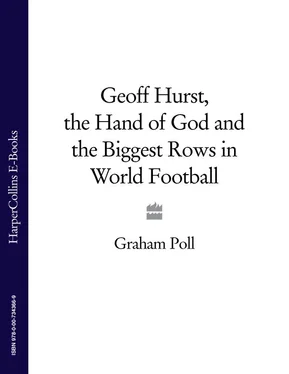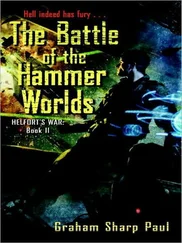The match ended 3-3. Middlesbrough won the replay. Chester-field’s chance of an historic Final appearance had gone. So don’t try telling anyone in Derbyshire that justice was served.
England’s George Courtney went to the World Cup in 1986 and 1990. He was one of the finest referees this country has ever produced, and a hero to me. But his preparation for those World Cups shows why the system of sending specialist assistant referees to major competitions is an improvement on what used to happen.
Only referees were sent to the World Cups of 1986 and 1990, so George had to take his turns as a linesman. He was a truly great referee, but hadn’t operated regularly as a linesman for years. In the build-up to both of his World Cups, he was given a handful of domestic games as a linesman, to try to re-familiarize himself with the job. But that merely underlines that the authorities accepted that he was out of practice.
George, a lovely man, was the referee in 1991 when I made my first ever international trip. We travelled to Rotterdam, for a Euro 92 qualifier between Holland and Portugal. I was one of George’s assistants and delighted to be chosen, but I was a Football League referee by then and decidedly rusty at running the line.
FACT! WHEN LINESMEN CAME…AND WENT
THE role of linesman is as old as football, but when the game was first played, the linesmen were not neutrals; they were spare players or other people associated with the two teams. That is still the case in much parks football and other ‘grass roots’ matches.
Originally, if a ‘lino’ saw any offence, he stuck up his flag and play had to stop. But the 1891 Laws of Football changed all that and made it clear that linesmen were only there to assist the referee, and that it was the ref who decided when to stop play. The 1891 Laws gave linesmen very limited powers and duties. Four years later, by which time some linesmen were neutral, a new edition of the Laws gave them more responsibility, but again made it clear that they were referees’ helpers.
The title ‘linesman’ was changed to ‘assistant referee’ for the start of the 1996/97 season, partly because there were many more lineswomenby then and partly because the authorities wanted recognition for the fact that linesmen and women were expected to do more to help the ref than just wave their flags from time to time.
FACT! FLAGGING, NOT WAVING
YOU will hear commentators say that an assistant has flagged for offside when it turns out to be for a foul, and vice versa. That’s because they don’t know the different signals.
For a foul, the assistant stands with the flag pointing along the touchline in the direction the free-kick will be taken.
For offside, he (or she) stands with the flag pointing towards the pitch—high in the air if the offside player was on the other side of the pitch, parallel with the ground if the offence was halfway across the pitch, and at an angle with the ground if the offence was on the assistant’s side of the field.
There are other, less conspicuous signals as well, especially at games below the level where there is radio communication. For instance, if an assistant is not sure which way to give a throw-in, he or she will wait until the referee has pointed with a finger or hand—subtly, almost imperceptibly. Then the assistant will not fall into the trap of signalling one direction and being overruled.
If it appears that there is disagreement between the referee and an assistant, there is far more likely to be dissent from players and abuse from spectators, so it is important for officials to avoid appearing to disagree. It is also important to remember that the ref is the one who makes the decisions. So, sometimes, assistants don’t signal for offences. Spectators and commentators will say, ‘The linesman must have seen that.’ But if the assistant knows that the ref has got a good view of an incident, it is not the assistant’s job to signal. It is good practice to leave it to the referee, because he might want to play an ‘advantage’.
THE fact that Tofik Bakhramov was the top man in Azerbaijan did not guarantee he was especially proficient as a referee, let alone as a linesman. FIFA feel obliged to appoint officials from all over the globe for World Cups, to encourage referees in every country. That means you don’t get the best officials.
If there were no considerations other than assembling the 20 finest refs, you would get eight or ten from Europe and six or seven from South America. Other than a few occasional, outstanding exceptions, the best referees come from countries with top-standard leagues and demanding matches. Yet at World Cups, there are always referees and assistants from smaller footballing nations with limited experience of really big games.
THERE have been very successful experiments on football goal-line technology by Hawk-Eye, the company which makes equipment which is accepted in tennis and is used in television coverage of cricket. The experiments, conducted at Fulham and Reading, were proposed by the Premier League and sanctioned by FIFA. Yet, in March 2008, the International Football Association Board (FIFA’s Laws committee) decreed that the experiments must end. They were persuaded by a ‘strongly-worded intervention’ from the president of UEFA, Michel Platini. He believes that, once you introduce any technology at all, you open Pandora’s box.
Platini was a wonderful player for France and Juventus and his election as president of UEFA in January 2007 made him the top administrator in Europe. His election was hailed by football folk because, at last, a former player was to be one of the game’s leaders. But, the next time your team is denied a good goal because the assistant referee did not see that the ball crossed the line, don’t blame the assistant and don’t blame the ref. The person you should blame is Michel Platini.
FROM the year 2000, to reduce ‘Ye-es’ moments, FIFA imposed some additional, standardized instructions for assistant referees.
If the ref signals for a foul near the penalty area and the assistant is sure it wasoutside the box, the assistant should take an exaggerated step towards the halfway line. If the assistant is certain the foul wasinside the area, he should run towards the corner flag.
FIFA do not want referees going over to talk to assistants, because that would look as if the ref is unsure about the decision and the players would surround the officials to have their say.
In my autobiography,Seeing Red, I recount an incident just like that in Euro 2000. I took charge of a match between the Czech Republic and France on 16 June in Bruges. Despite those careful, homogenized instructions on what to do about penalty decisions, I still went over to my assistant, Eddie Foley from Cork, to find out what had happened. We gave a penalty instead of a free-kick outside the area. We got the decision wrong. And UEFA were not happy that I had ignored the directive.
Dave Bryan was one of the best assistant referees I worked with, but he had his own ‘66 moment on 3 January 2004, when he signalled for a goal by Watford’s Heidar Helguson against Chelsea. The ball hit the bar and bounced down on—or, according to Dave, over—the line.
Читать дальше












